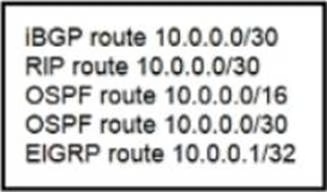Cisco 200-301 Implementing and Administering Cisco Solutions Online Training
Cisco 200-301 Online Training
The questions for 200-301 were last updated at Dec 17,2025.
- Exam Code: 200-301
- Exam Name: Implementing and Administering Cisco Solutions
- Certification Provider: Cisco
- Latest update: Dec 17,2025
Which statement identifies the functionality of virtual machines?
- A . Virtualized servers run most efficiently when they are physically connected to a switch that is separate from the hypervisor
- B . The hypervisor can virtualize physical components including CPU. memory, and storage
- C . Each hypervisor can support a single virtual machine and a single software switch
- D . The hypervisor communicates on Layer 3 without the need for additional resources
Which type of address is the public IP address of a NAT device?
- A . outside global
- B . outsdwde local
- C . inside global
- D . insride local
- E . outside public
- F . inside public
Which option about JSON is true?
- A . uses predefined tags or angle brackets () to delimit markup text
- B . used to describe structured data that includes arrays
- C . used for storing information
- D . similar to HTML, it is more verbose than XML
How do TCP and UDP differ in the way they provide reliability for delivery of packets?
- A . TCP is a connectionless protocol that does not provide reliable delivery of data, UDP is a connection-oriented protocol that uses sequencing to provide reliable delivery.
- B . TCP does not guarantee delivery or error checking to ensure that there is no corruption of data UDP provides message acknowledgement and retransmits data if lost.
- C . TCP provides flow control to avoid overwhelming a receiver by sending too many packets at once, UDP sends packets to the receiver in a continuous stream without checking for sequencing
- D . TCP uses windowing to deliver packets reliably; UDP provides reliable message transfer between
hosts by establishing a three-way handshake
Which two command sequences must you configure on switch to establish a Layer 3 EtherChannel with an open-standard protocol? (Choose two)
- A . interface GigabitEthernet0/0/1
channel-group 10 mode on - B . interface GigabitEthernet0/0/1
channel-group 10 mode active - C . interface GigabitEthernet0/0/1
channel-group 10 mode auto - D . interface port-channel 10 switchport
switchport mode trunk - E . interface port-channel 10 no switchport
ip address 172.16.0.1.255.255.255.0
What is an advantage of Cisco DNA Center versus traditional campus device management?
- A . It supports numerous extensibility options including cross-domain adapters and third-party SDKs.
- B . It supports high availability for management functions when operating in cluster mode.
- C . It enables easy autodiscovery of network elements m a brownfield deployment.
- D . It is designed primarily to provide network assurance.
Refer to the exhibit.

A router reserved these five routes from different routing information sources.
Which two routes does the router install in its routing table? (Choose two)
- A . RIP route 10.0.0.0/30
- B . iBGP route 10.0.0.0/30
- C . OSPF route 10.0.0.0/30
- D . EIGRP route 10.0.0.1/32
- E . OSPF route 10.0.0.0/16
By default, how Does EIGRP determine the metric of a route for the routing table?
- A . it uses the bandwidth and delay values of the path to calculate the route metric
- B . it uses a default metric of 10 for all routes that are learned by the router
- C . it uses a reference Bandwidth and the actual bandwidth of the connected link to calculate the route metric
- D . it counts the number of hops between the receiving and destination routers and uses that value as the metric
What is a difference between local AP mode and FiexConnet AP mode?
- A . Local AP mode creates two CAPWAP tunnels per AP to the WLC
- B . FiexConnect AP mode fails to function if the AP loses connectivity with the WLC
- C . FlexConnect AP mode bridges the traffic from the AP to the WLC when local switching is configured
- D . Local AP mode causes the AP to behave as if it were an autonomous AP
Router R1 must send all traffic without a matching routing-table entry to 192.168.1.1.
Which configuration accomplishes this task?
- A . R1#config t
R1(config)#ip routing
R1(config)#ip route default-route 192.168.1.1 - B . R1#config t
R1(config)#ip routing
R1(config)#ip route 192.168.1.1 0.0.0.0 0.0.0.0 - C . R1#config t
R1(config)#ip routing
R1(config)#ip route 0.0.0.0 0.0.0.0 192.168.1.1 - D . R1#config t
R1(config)#ip routing
R1(config)#ip default-gateway 192.168.1.1
Latest 200-301 Dumps Valid Version with 489 Q&As
Latest And Valid Q&A | Instant Download | Once Fail, Full Refund

